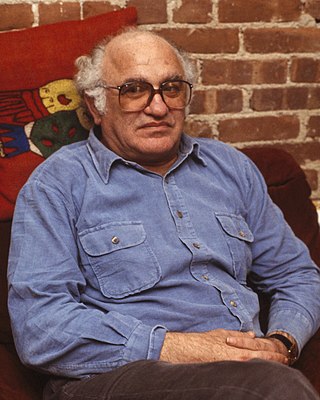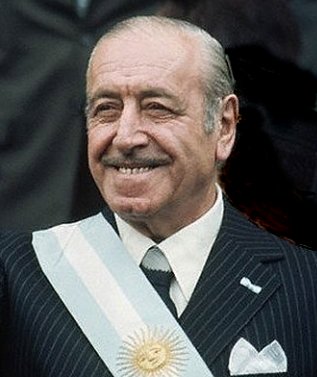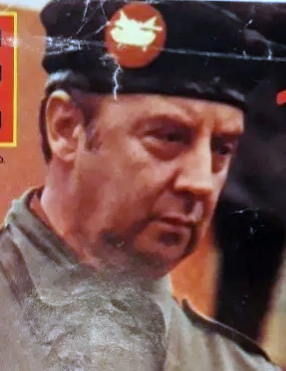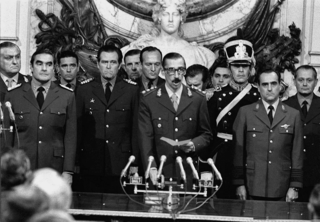
Jacobo Timerman was a Soviet-born Argentine publisher, journalist, and author, who is most noted for his confronting and reporting the atrocities of the Argentine military regime's Dirty War during a period of widespread repression in which an estimated 30,000 political prisoners were disappeared. He was persecuted, tortured and imprisoned by the Argentine junta in the late 1970s and was exiled in 1979 with his wife to Israel. He was widely honored for his work as a journalist and publisher.

Isabel Martínez de Perón is an Argentine former politician who served as the 46th President of Argentina from 1974 to 1976. She was one of the first female republican heads of state in the world, and the first woman to serve as president of a country. Perón was the third wife of President Juan Perón. During her husband's third term as president from 1973 to 1974, she served as both the 29th Vice President and First Lady of Argentina. From 1974 until her resignation in 1985, she was also the 2nd President of the Justicialist Party.

Jorge Rafael Videla was an Argentine military officer and dictator who was the 47th President of Argentina and as well as the 1st President of the National Reorganisation Process from 1976 to 1981. His rule, which was during the time of Operation Condor, was among the most infamous in Latin America during the Cold War due to its high level of human rights abuses and severe economic mismanagement.

Héctor José Cámpora was an Argentine politician. A major figure of left-wing Peronism, Cámpora was briefly Argentine president from 25 May to 13 July 1973 and subsequently arranged for Juan Perón to run for president in an election that he subsequently won. The modern left-wing Peronist political youth organization La Cámpora is named after him. He was a dentist by trade.

Alejandro Agustín Lanusse Gelly was the de facto president of the Argentine Republic between March 22, 1971, and May 25, 1973, during the military dictatorship of the country called the "Argentine Revolution".

The Dirty War is the name used by the military junta or civic-military dictatorship of Argentina for the period of state terrorism in Argentina from 1974 to 1983 as a part of Operation Condor, during which military and security forces and death squads in the form of the Argentine Anticommunist Alliance hunted down any political dissidents and anyone believed to be associated with socialism, left-wing Peronism, or the Montoneros movement.

José López Rega was an Argentine politician who served as Minister of Social Welfare from 1973 to 1975, first under Juan Perón and continuing under Isabel Perón, Juan Perón's third wife and presidential successor. Lopez Rega exercised an allegedly Rasputin-like power and influence over Isabel Perón during her presidency, and used both this and his unique access to become the de facto political boss of Argentina. His orthodox peronist and far-right politics and interest in the occult earned him the nickname El Brujo. Rega had one daughter, Norma Beatriz, who went on to become the spouse of President Raúl Lastiri.

The Ezeiza massacre took place on June 20, 1973, at Puente 12, the intersection of General Ricchieri freeway and Camino de Cintura, some 10 km from Ezeiza International Airport in Buenos Aires, Argentina.

José Ber Gelbard was a Polish-born Argentine activist and politician, and a member of the Argentine Communist Party. He also helped organize the Confederación General Económica (CGE), made up of small and medium-sized business. Beginning about 1954, he was appointed as an economic advisor to Juan Perón and repeatedly was called back to serve as Minister of Finance to successive governments until the military coup of March 1976. He fled with his family shortly before the coup, gaining political asylum in the United States and settling in Washington, D.C.

Carlos Guillermo Suárez Mason was an Argentine military officer convicted for Dirty War crimes during the 1976–1983 military dictatorship. He was in charge of the Batallón de Inteligencia 601.

The Movimiento Nacionalista Tacuara was an Argentine far right, orthodox Peronist, and fascist movement. While officially established in 1957, its activities started in 1955, and continued through the 1960s, being integrated in Juan Perón's right-wing "Special Formations". Linked to the more radical sectors of the Peronist movement and directly inspired by Julio Meinvielle's Catholic pronouncements, Tacuara defended nationalist, Catholic, anti-liberal, anti-communist, antisemitic, and anti-democratic ideas, and had as its first model José Antonio Primo de Rivera's fascist Falange Española. In the years 1960–1966, the movement incorporated neo-Nazi elements.

The 1976 Argentine coup d'état overthrew Isabel Perón as President of Argentina on 24 March 1976. A military junta was installed to replace her; this was headed by Lieutenant General Jorge Rafael Videla, Admiral Emilio Eduardo Massera and Brigadier-General Orlando Ramón Agosti. The political process initiated on 24 March 1976 took the official name of "National Reorganization Process", and the junta, although not with its original members, remained in power until the return to the democratic process on 10 December 1983. The coup was planned and executed within the framework of the Condor Plan, a clandestine system of coordination between Latin American countries promoted by the United States, as part of the national security doctrine, which generalized dictatorships in Latin America in order to maintain stability in those countries during the Cold War and avoid something worse.

Argentine Revolution was the name given by its leaders to a military coup d'état which overthrew the government of Argentina in June 1966 and began a period of military dictatorship by a junta from then until 1973.
The history of Argentina can be divided into four main parts: the pre-Columbian time or early history, the colonial period (1536–1809), the period of nation-building (1810–1880), and the history of modern Argentina.
David Kraiselburd (1912–1974) was an Argentine journalist, newspaper publisher, and lawyer, best known for his commitment and actions against military regimes and political violence of both right- and left-wing extraction. He was assassinated shortly after the beginning of the Dirty War—in mid-1974—and shortly before the military coup.

Juan Domingo Perón was an Argentine lieutenant general, politician and statesman who served as the 35th President of Argentina from 1946 to his overthrow in 1955, and again as the 45th President from October 1973 to his death in July 1974. He had previously served in several government positions, including Minister of Labour and Vice President under presidents Pedro Pablo Ramírez and Edelmiro Farrell. Perón is the only Argentine president elected three times and holds the highest percentage of votes (61.86%) in clean elections with universal suffrage. Peron's ideas, policies and movement are known as Peronism, which continues to be one of the most influential forces in Argentine politics.

The 1943 Argentine coup d'état was a coup d'état on 4 June 1943 that ended the government of Ramón Castillo, who had been fraudulently elected to the office of vice-president before succeeding to the presidency in 1942 as part of the period known as the Infamous Decade. The coup d'état was launched by the lodge of the "United Officer Groups", a secret military organization of nationalist nature. Although its soldiers shared different views of nationalism: there were Catholic nationalists, Radicals, military with a more pragmatic approach, and even fascists. The military was opposed to Governor Robustiano Patrón Costas, Castillo's hand-picked successor, a major landowner in Salta Province and a primary stockholder in the sugar industry. The only serious resistance to the military coup came from the Argentine Navy, which confronted the advancing army columns at the Navy Petty-Officers School of Mechanics.
In Argentina, there were six coups d'état during the 20th century: in 1930, 1943, 1955, 1962, 1966 and 1976. The first four established interim dictatorships, while the last two established dictatorships of permanent type on the model of a bureaucratic-authoritarian state. The latter conducted a Dirty War in the line of State terrorism, in which human rights were systematically violated and there were tens of thousands of forced disappearances.

Juan Manuel Abal Medina is an Argentine journalist and politician who served as Secretary General of the Peronist Movement between 1972 and 1974. He later became a prominent lawyer in Mexico.
Tendencia Revolucionaria, Tendencia Revolucionaria Peronista, or simply la Tendencia or revolutionary Peronism, was the name given in Argentina to a current of Peronism grouped around the guerrilla organisations FAR, FAP, Montoneros and the Juventud Peronista. Formed progressively in the 1960s and 1970s, and so called at the beginning of 1972, it was made up of various organisations that adopted a combative and revolutionary stance, in which Peronism was conceived as a form of Christian socialism, adapted to the situation in Argentina, as defined by Juan Perón himself. The Tendencia was supported and promoted by Perón, during the final stage of his exile, because of its ability to combat the dictatorship that called itself the Argentine Revolution. It had a great influence in the Peronist Resistance (1955-1973) and the first stage of Third Peronism, when Héctor J. Cámpora was elected President of the Nation on 11 March 1973.














